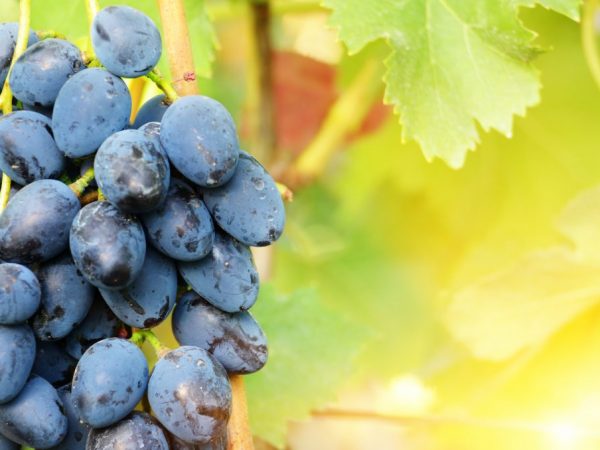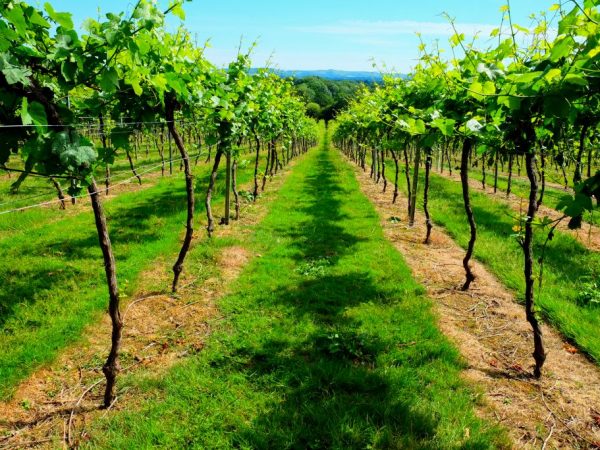Early Magarach grape
Grapes are a perennial crop that grows as a shrub. It is grown independently to obtain berries, which are processed into juices and wines, and also consumed fresh. The Magarach grape is a popular early variety due to its good yield.

Early Magarach grape
Characteristics of grapes
The early Magaracha grape is a hybrid variety. It is the result of crossing Black raisins and Madeleine-Angevin. It is widely used in the preparation of wine and other alcoholic beverages.
The berry has good frost resistance. Magaracha normally tolerates a temperature of -18 ° C. The popularity of the variety is due to its fast ripening period. From the beginning of the growing season to the ripening of the fruits, no more than 130 days pass. The vine has a beautiful appearance, which allows you to use the plant as a decorative element.
Description of the bush
At the initial stage of development, the plant is characterized by sprawling shoots, which eventually become strong and powerful. On a young shrub, the vine has a yellowish-bronze color. With development, bright green leaves appear, consisting of 5 lobes. A vigorous bush withstands up to 45 eyes.
Also, a feature of the Early Magarach 372 grape is that the central segment of the leaves is smaller than the lateral ones, which gives the surface an unusual pattern. At the beginning of autumn, the foliage turns yellow and becomes covered with spots of a red hue.
Description of fruits
Medium-dense clusters of Magarach are made in the form of an elongated cone, which reaches 23 cm in length. Their weight is 400 g, but there are also larger representatives. The density of the bunches depends on the season and climatic conditions of the region. In some areas, they take on a different form.
The weight of a grape berry does not exceed 5 g. It contains few seeds. The color of the fruits is dark blue, in sunny regions they are purple. The variety is characterized by a coating with a thin layer of waxy bloom on the berries, which gives them shine and velvety.
The pulp is juicy and fleshy, has a dark pink color. The taste is sweet, with a pleasant sourness, which makes the variety suitable for winemaking. There is also chocolate or blueberry in the aroma. The dense skin allows safe transportation of fruits.
Chemical characteristics of the fruit:
- juice - 85.4%;
- sugar - 17.3 g;
- acidity - 6.5%.
Growing grapes
The description of the methods of planting the Magarach Grape is similar to that of other early fast-fruiting varieties. It is important to choose the right type of soil and location. It must be sheltered from strong winds and also have sufficient sunshine.
The looser the soil, the more oxygen and moisture are supplied to the roots. Saplings are planted in spring, April or early May, and also in autumn.
Landing in the soil

Plants love sunlight
Planting of Magarach 372 grapes is carried out in soils of this type:
- loamy;
- slate;
- chestnut
- sandy and sandy loam (using black soil bedding).
For planting, use the cuttings method. They are planted in a hole 50 cm deep, with several shanks in each. At the bottom of the hole is a layer of soil mixture, as well as the required amount of water and fertilizer. A seedling is placed in it and sprinkled with soil, without tamping.
The distance between the bushes should be in the range of 1.7-2.2 m. To prevent the death of the first-born grapes, it is covered with a layer of mulch.
Plant care
Description of caring for the Magarach grapes:
- In the spring. The winter shelter is removed from the bushes, stagnant water is removed.
- In summer. Tying and pinching of new segments is carried out, as well as preventive spraying and examination for the presence of diseases.
- In the autumn. In the period after harvest, pre-winter spraying is carried out. Weak and diseased shoots are also removed, and the bushes are prepared for wintering. Before the beginning of winter, the grapes are covered with soil or branches.
- In winter. It is required to regularly remove excess snow from the surface of the soil where the bushes grow.
Fertilizer
Magarach grapes require organic fertilizers:
- manure;
- chicken droppings;
- peat;
- wood ash.
Minerals:
- potassium (Ca);
- nitrogen (N);
- phosphorus (Ph).
Watering
Moisture application schedule for Magarach grapes:
- after planting in the soil;
- before tying;
- 5-8 days after pruning;
- when shoots appear with a height of 28-33 cm;
- a week before the beginning of the flowering period;
- in the initial phase of the formation of bunches;
- a week before picking berries;
- moisture-saturating - 2 weeks before winter.
Diseases and pests

Due to diseases, the plant loses leaves and fruits.
The Magarach grapes are exposed to the following diseases:
- mildew;
- gray rot;
- powdery mildew;
- anthractosis;
- black spot.
Pests of the variety:
- grape aphid
- mite;
- goldfish;
- phyloxera;
- cobweb;
- cicadas;
- leaf roll;
- goldfish.
Fungal diseases damage the branches and spread to the fruit. The reason for their appearance is the high moisture content of the soil. They are also carried by some insects. Diseases cause loss of foliage and berries.
Pests feed on grape juice, which makes the berries more withered. Also, insect larvae make moves in the branches, which causes the formation of rot.
Fight disease
Systemic and contact fungicides are used to fight diseases. They are applied by spraying.
Effective remedies for the treatment of grapes:
- Horus;
- Thanos;
- "Acrobat";
- Ridomil;
- "Strobe";
- Tiovit;
- cuprous chloride;
- inkstone;
- bordeaux liquid.
Pest control
To combat pests of grapes, drugs are used:
- "Nitrafen";
- "Karbofos";
- "Zolon";
- Actellik;
- Aktara;
- "Confidor";
- "Neoron".
Prophylaxis
The main method of preventing grape diseases is timely care. They also regularly inspect the bush for signs of fungus, rot, or harmful insects.
Folk remedies such as onion peels or ash help well. Decoctions or solutions are prepared from them, which are added to the soil of the trunk circle.
Conclusion
The Magarach 372 grape is a good variety for cultivation for making homemade wine. With timely care, it will give a good harvest.
The use of chemicals is limited 2 weeks before harvest, as they make it unfit for food. In rainy regions, it is better to use systemic drugs.


